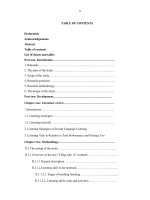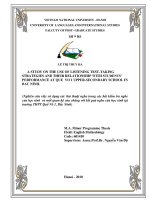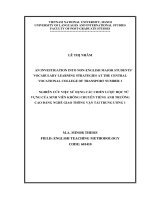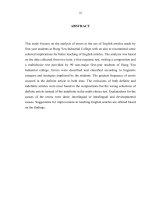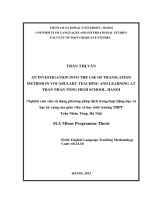The use of English vocabulary learning strategies among university students
Bạn đang xem bản rút gọn của tài liệu. Xem và tải ngay bản đầy đủ của tài liệu tại đây (1.3 MB, 118 trang )
LAC HONG UNIVERSITY
Faculty of English Language
-------------------
RESEARCH REPORT
The use of English vocabulary learning strategies
among university students: Lac Hong university
Name: Nguyen Thi Thuy Trang
Class: 15AV112
December 2019
LAC HONG UNIVERSITY
Faculty of English Language
-------------------
RESEARCH REPORT
The use of English vocabulary learning strategies
among university students: Lac Hong university
Name: Nguyen Thi Thuy Trang
Class: 15AV112
Advisor: Trinh Dieu Hien, MA.
Nguyen Van Tan, PhD.
The use of English vocabulary learning strategies
among December
university2019
students
The use of English vocabulary learning strategies
among university students
DECLARATION
I, Nguyen Thi Thuy Trang, certify that the thesis entitled “The use of English
vocabulary learning strategies among university students” is my work and has not
previously been submitted for a degree or similar award at another institution.
Dong Nai, 2019
Nguyen Thi Thuy Trang
ACKNOWLEDGEMENTS
This research would have not been completed without the invaluable help of many
people, to whom my grateful acknowledgments are extended.
First and foremost, I would like to express my gratitude and appreciation to my
advisors, Mrs. Trinh Dieu Hien, MA, Mr. Nguyen Van Tan, PhD., for their helpful
guidance, practical suggestion, precious advice, great encouragement, and
enthusiastic supervision. They helped and supported me all the ways, so that I could
meet the research deadline.
I am also extremely grateful to lecturers of Faculties at Lac Hong University who
wholeheartedly supported me during my conduct of the survey. Without their
facilitation, I could hardly keep up with the research schedule. Besides, my special
thanks are addressed to Lac Hong university students who take the time to complete
the questionnaires.
Finally, my appreciation for the support, understanding, and sympathy are sent to
my beloved family and friends.
ABSTRACT
Learning vocabulary has become an integral part of students' English language
learning, and vocabulary learning strategies have been considered as approaches
greatly facilitating the vocabulary learning process of students. This study, therefore,
with the aims of identifying the types of vocabulary learning strategies currently
used by university students and investigating differences (if any) in vocabulary
learning strategies use according to gender, university year groups and academic
majors, hope to provide a better understanding to fully support students in this
journey.
This is quantitative research and research design is under the form of a survey. Data
has been collected through the questionnaire and for analysis purposes, SPSS
software has been used. The results reveal that students use various strategies in
their vocabulary learning processes. Among them, learning spellings of the words to
remember them and using dictionaries to find new English words’ meanings to
remember the words are greater use. Besides, significant differences in the use of
specific vocabulary learning strategies based on gender, university year groups, and
academic majors are found.
i
TABLE OF CONTENTS
CHAPTER 1 ............................................................................................................... 1
INTRODUCTION ...................................................................................................... 1
1.1 Introductory paragraph ...................................................................................... 1
1.2 Statement of the probem ................................................................................... 1
1.3. Purposes of the study ....................................................................................... 2
1.4. Significance of the study .................................................................................. 2
1.5. Scope of the study ............................................................................................ 3
1.6. Research Questions .......................................................................................... 3
1.7. Research Hypothesis ........................................................................................ 3
CHAPTER 2 ............................................................................................................... 4
LITERATURE REVIEW ........................................................................................... 4
2.1 Language Learning Strategies ........................................................................... 4
2.1.1 Definitions of Language Learning Strategies ............................................. 4
2.1.2 Classification of Language Learning Strategies ......................................... 5
2.1.2.1 Language learning strategies’ classification of Bialystok 1978 ........... 5
2.1.2.2 Language learning strategies’ classification of Carver 1984 ............... 6
2.1.2.3 Language learning strategies’ classification of O'Malley et al 1985 ... 8
2.1.2.4 Language learning strategies’ classification of O’Maley and Chamot
1990 .................................................................................................................. 9
2.1.2.5 Language learning strategies’ classification of Oxford 1990 ............ 11
2.2 Vocabulary Learning Strategies ...................................................................... 18
2.2.1 Definitions of Vocabulary Learning Strategies ........................................ 18
2.2.2 Classification of Vocabulary Learning Strategies .................................... 19
2.2.2.1 Vocabulary learning strategies’ classification of Schmitt and Schmitt
1993 ................................................................................................................ 19
2.2.2.2. Vocabulary learning strategies’ classification of Gu and Johnson
1996 ................................................................................................................ 22
ii
2.2.2.4 Vocabulary learning strategies’ classification of Schmitt 1997 ......... 25
2.2.3 Studies on vocabulary learning strategy use of students .......................... 28
CHAPTER 3 ............................................................................................................. 32
RESEARCH METHODOLOGY AND PROCEDURE........................................... 32
3.1 Aims and Objectives ....................................................................................... 32
3.2 Methodology ................................................................................................... 32
3.3. Population and sampling ................................................................................ 32
3.4. Data collection ............................................................................................... 33
3.5 Procedure......................................................................................................... 34
3.6. Analysis plan .................................................................................................. 35
CHAPTER 4 ............................................................................................................. 36
FINDINGS AND DISCUSSION ............................................................................. 36
4.1 The characteristics of respondents .................................................................. 36
4.1.1 The vocabulary learning questionnaire ..................................................... 36
4.1.1.1 Participants’ gender ............................................................................ 36
4.1.1.2 Participants’ university year groups ................................................... 36
4.1.1.3 Participants’ academic majors ............................................................ 37
4.2 Findings and discussion of research questions ............................................... 38
4.2.1 Research question 1 .................................................................................. 38
4.2.2 Research question 2 .................................................................................. 41
4.2.2.1 Gender differences in vocabulary learning strategy use .................... 41
4.2.2.2 University year group differences in vocabulary learning strategy use
........................................................................................................................ 45
4.2.2.3 Major differences in vocabulary learning strategy use ............................. 51
CHAPTER 5 ............................................................................................................. 71
CONCLUSIONS AND RECOMMENDATIONS ................................................... 71
5.1. The summary of the main findings of the study ............................................ 71
5.1.1 Vocabulary learning strategies currently used by students ...................... 71
5.1.2. The difference in vocabulary learning strategy use ................................. 73
iii
5.1.2.1 Gender differences in vocabulary learning strategy use .................... 73
5.1.2.2 University year group differences in vocabulary learning strategy use
........................................................................................................................ 74
5.1.2.3 Major differences in vocabulary learning strategy use ...................... 74
5.2 Contributions of the study ............................................................................... 75
5.3 Implications of the study ................................................................................. 76
5.4 Limitations and recommendations for further research .................................. 77
REFERENCES ......................................................................................................... 79
APPENDIX A........................................................................................................... 82
APPENDIX B ........................................................................................................... 87
APPENDIX C ........................................................................................................... 91
APPENDIX D........................................................................................................... 97
APPENDIX E ......................................................................................................... 100
APPENDIX F ......................................................................................................... 104
iv
LIST OF TABLES
Table 1. Bialystok’s (1978) language learning strategies classification .................... 6
Table 2. Carver’s (1984) language learning strategies classification ......................... 7
Table 3. O'Malley et al. (1985) language learning strategies classification ............... 8
Table 4. O’Maley and (Chamot 1990) language learning strategies classification ... 9
Table 5a. Oxford (1990) language learning strategies classification ....................... 12
Table 5b. Oxford (1990) language learning strategies classification ....................... 15
Table 6. Schmitt and Schmitt’s (1993) vocabulary learning strategies classification
.................................................................................................................................. 20
Table 7. A summary of Gu and Johnson (1996) vocabulary learning strategies
classification ............................................................................................................. 23
Table 8. Lawson and Hogben (1996) vocabulary learning strategies classification 24
Table 9. Schmitt (1997) vocabulary learning strategies classification ..................... 26
Table 10 Frequencies of participants’ gender .......................................................... 36
Table 11 Frequencies of participants’ university year groups ................................. 37
Table 12 Frequencies of participants’ academic majors .......................................... 37
Table 13 Means of vocabulary strategy use ............................................................. 39
Table 13 Means of vocabulary strategy use (cont)................................................... 39
Table 13 Means of vocabulary strategy use (cont)................................................... 40
Table 13 Means of vocabulary strategy use (cont)................................................... 40
Table 14 Other vocabulary learning strategies used by students ............................. 40
Table 15 Independent samples test on vocabulary use by gender ............................ 43
Table 16 Means of the vocabulary learning strategies use by gender ...................... 44
Table 17 ANOVA tests on vocabulary learning strategy use by university year
group ......................................................................................................................... 45
Table 18 Post Hoc Tests on DET1 by university year group ................................... 46
Table 19 Means of DET1 by university year group ................................................. 47
Table 20 Post Hoc Tests on SOC1 by university year group ................................... 48
v
Table 21 Means of SOC1 by university year group ................................................. 49
Table 22 Post Hoc Tests on SOC3 by university year group ................................... 50
Table 23 Means of SOC3 by university year group ................................................. 51
Table 24 ANOVA tests on vocabulary learning strategy use by academic major ... 52
Table 25 Post Hoc Tests on DET1 by academic major ............................................ 54
Table 26 Means of DET1 by academic major .......................................................... 55
Table 27 Post Hoc Tests on DET2 by academic major ............................................ 56
Table 28 Means of DET2 by academic major .......................................................... 57
Table 29 Post Hoc Tests on DET3 by academic major ............................................ 57
Table 30 Means of DET3 by academic major .......................................................... 58
Table 31 Post Hoc Tests on DET4 by academic major ............................................ 59
Table 32 Means of DET4 by academic major .......................................................... 60
Table 33 Post Hoc Tests on SOC1 by academic major ............................................ 60
Table 34 Means of SOC1 by academic major .......................................................... 61
Table 35 Post Hoc Tests on SOC3A by academic major ......................................... 62
Table 36 Means of SOC3A by academic major ....................................................... 63
Table 37 Post Hoc Tests on MEM1 by academic major .......................................... 64
Table 38 Means of MEM1 by academic major ........................................................ 64
Table 39 Post Hoc Tests on MEM3 by academic major .......................................... 65
Table 40 Means of MEM3 by academic major ........................................................ 66
Table 41 Post Hoc Tests on MEM7 by academic major .......................................... 67
Table 42 Means of MEM7 by academic major ........................................................ 67
Table 43 Post Hoc Tests on MET2 by academic major ........................................... 68
Table 44 Means of MET2 by academic major ......................................................... 69
vi
CHAPTER 1
INTRODUCTION
1.1 Introductory paragraph
Learning a new language requires students to make a great effort because “it entails
learning many aspects, including pronunciation, writing system, syntax, pragmatics,
rhetorical modes for reading and composition, culture, and spelling, but the most
important aspect is vocabulary." (Folse, 2004, p.1). In the same vein, Grass and
Selinker (1994, p.270) also point out that “lexicon is the most important component
for learners.” Discussing the reasons why vocabulary is thought to be the most vital
factor of the language learning process, Lewis (1993, p.89) states, “lexis is the core
or heart of language.” Moreover, “without grammar, very little can be conveyed,
without vocabulary, nothing can be conveyed, and there is not much value in being
able to produce grammatical sentences if one has not got the vocabulary that is
needed to convey what one wishes to say” (Wilkins 1972, p.111).
Although the importance of vocabulary has been recognized, learning vocabulary is
considered as a very difficult task for students. Being aware of this, researchers in
many countries conduct various studies on strategies that learners use when they
learn vocabulary. Researchers believe that students can gain a vast quantity of
vocabulary easily with the help of vocabulary learning strategies, and that these
strategies are useful to students at different language levels (Nation, 2001).
Furthermore, “vocabulary learning strategies develop the autonomy of the students
by allowing self-directed involvement and helping them gain control of their
learning.” (Wanpen et al., 2013, p.313). By determining the vocabulary learning
strategies used by students, researchers hope for giving some suggestions on how to
facilitate students in vocabulary acquisition.
1.2 Statement of the problem
Being one of the most popular languages in the world, English seems to be the first
choice for students who intend to learn a new foreign language. In that general
1
context, students in Vietnam are not the exception. They also choose to learn
English and face difficulties when learning vocabulary.
However, after examining the literature review in this field, the researcher realizes
that studies on vocabulary learning strategies are seemly in the early stage in
Vietnam. Very few published research in Vietnam carry on this topic. Besides,
studies both determine the vocabulary learning strategies use of students overall and
examine the differences in the use of these strategies based on many specific factors
like gender, university year groups, academic majors at the same time are rare. Thus,
to fill these gaps, the researcher undertakes a study on the topic: “The use of
English vocabulary learning strategies among university students”.
1.3. Purposes of the study
The purposes of this study are (1) to investigate the use of vocabulary learning
strategies among university students overall, and (2) to explore the differences in
vocabulary learning strategy use of students according to specific factors.
1.4. Significance of the study
Once the present research is completed, its findings are expected to benefit people
who are interested in this topic and fill the gaps in the field. Particularly, the
significance of this study will be:
First, university students will become aware of the vocabulary learning strategies
they are using, and know more about some other vocabulary learning strategies.
Base on these facts, they, themselves, can consider and choose the appropriate
vocabulary learning strategies as well as related activities for better vocabulary
learning outcomes.
Second, teachers will know what vocabulary learning strategies students currently
use, and acknowledge differences in vocabulary learning strategy use according to
gender, university year groups, and academic majors (if any). In this way, they can
make adjustments to teaching vocabulary in classes. Besides, they can encourage or
2
advise students to choose suitable vocabulary learning strategies and implement
them to self-study English vocabulary.
Third, for researchers, especially researchers in Vietnam, who concern about
vocabulary learning strategies, this research can be a useful reference for their
studies. It will give them a clearer view of this topic.
Fourth, the researcher hopes that this study will fill the gaps in the field; thereby it
provides the extension of literature.
1.5. Scope of the study
This study investigates the use of vocabulary learning strategies among university
students overall, and explore the differences in vocabulary learning strategy use of
students according to specific factors. 917 students at Lac Hong University are
selected as sample for this research. Data is collected via questionnaires from
October 31, 2019 to November 24, 2019.
1.6. Research Questions
The present study seek to answers the following research questions:
1. What vocabulary learning strategies currently used by university students?
2. Are there any differences in vocabulary learning strategies use in terms of gender,
university year groups, and academic majors?
1.7. Research Hypothesis
It is hypothesized that there are differences in vocabulary learning strategies use
according to gender, university year groups, and academic majors.
3
CHAPTER 2
LITERATURE REVIEW
2.1 Language Learning Strategies
As a branch of language learning strategies is Vocabulary learning strategies, it is
vital to know how language learning strategies are defined and classified first.
2.1.1 Definitions of Language Learning Strategies
Researchers define language learning strategies in different ways. The early
definition is given by Rubin (1975, p. 43), who regards language learning strategies
as “techniques or devices which a learner may use to acquire knowledge.” In
Bialystok's (1978) definition, language learning strategies were optional means that
learners use to exploit information with the aim of make competence in a second
language better. Oxford and Crookall (1989) have the same idea as Bialystok (1978)
about language learning strategies. They state that language learning strategies are
“the behaviors used by learners to move toward proficiency or competence in a
second or foreign language” (Oxford & Crookall, 1989, p. 404). From Oxford’s
(1989) perspective, language learning strategies are “behaviors or actions” used by
the learners to make the language learning process “more successful, self-directed,
and enjoyable” (p.235). Similarly, “specific actions which were taken by the learner
to make learning easier, faster, more enjoyable, more self-directed, more effective,
and more transferable to new situations” (p. 8) are the definition of language
learning strategies provided by Oxford (1990).
Maclntyre (1994) also contributes to language learning strategies’ definition by
saying that techniques and tricks the learners use for making the target language
learning easier are called language learning strategies. Ghani (2003) provides
another definition of language learning strategies. The author writes that language
learning strategies are “specific actions, behaviors, steps, or techniques that students
(often intentionally) use for improving their progress in developing L2 skill,” and
assumes that these strategies can facilitate the internalization, storage, retrieval, or
4
use of the new language" (Ghani, 2003, p.31). According to Cohen’s (2014)
definition, language learning strategies are “strategies for (1) identifying the
material that needs to be learned, (2) distinguishing it from other material if need be,
(3) grouping it for easier learning, (4) having repeated contact with the material, and
(5) formally committing to memory whatever material is not acquired naturally
through exposure” (p.12). From definitions of language learning strategies above, it
can be concluded that there are various language learning strategies’ definitions.
The following discussion is definitions of Vocabulary Learning Strategies.
2.1.2 Classification of Language Learning Strategies
From many definitions of language learning strategies, there are also various
language learning strategies’ taxonomies suggested by researchers. This part
respectively presents the language learning strategies taxonomies suggested by
some researchers. They are Bialystok (1978), Carver (1984), O'Malley et al. (1985),
O’Maley & Chamot (1990), Oxford (1990), and Intaraprasert (2000).
2.1.2.1 Language learning strategies’ classification of Bialystok 1978
Bialystok (1978) divided language learning strategies into three groups (1)
practicing, (2) monitoring, and (3) inferencing strategies. The practicing strategy
group is thought-about as actions concentrating on understanding the meaning and
properties of the target language. This group consists of two sub-strategies,
specifically formal and functional strategies. Formal strategies are actions
concentrating on remembering spellings of words. Functional strategies, meanwhile,
are actions focusing on messages' meanings. The two next strategies groups are
called monitoring and inferencing. The former refers to learners' actions learners
take to convey the messages' meanings effectively. The latter covers learners'
actions to deduce unknown information based on the information they have known.
Table 1 below presents a summary of Bialystok's (1978) language learning
strategies classification.
5
Table 1. Bialystok’s (1978) language learning strategies classification
A. Practicing strategies
1. Formal
2. Functional
B. Monitoring strategies.
C. Inferencing strategies
2.1.2.2 Language learning strategies’ classification of Carver 1984
Language learning strategies, in Carver's (1984) opinion, are classified into four
main groups, particularly strategies for (1) coping with target language rules, (2)
organizing learning, (3) receiving performance, and (4) producing performance. The
first strategy group includes some strategies such as transfer from mother language,
simplification, reinterpretation, hypercorrection, generalization. The second ones
involve some strategies like repetition, cognition, revision, peer group, contact with
teachers.
In the next two strategies groups called receiving and producing performance, the
researcher proposes their subgroups together with their subsets. The first group
covers inferring from probability and knowledge of the world, checking by asking
for simplification, or by rereading, predicting from contextual clues and identifying
key terms from chance or frequency. These strategies, in general, refer to deal with
language performance. The second group relates repeating sentences, labeling by
function lifting of ideas/sentences, and monitoring reception by requesting
comment/ question tags. Below is the detailed outline of Carver’s (1984) language
learning strategies.
6
Table 2. Carver’s (1984) language learning strategies classification
A. Strategies
for coping
1. Simplification
3. Reinterpretation
5. Generalization
2. Transfer from L1
4. Hypercorrection
6. Elimination of
with target
register difference
language rules
B. Strategies
for organizing
1. Repetition
5. Peer group
8. ‘Cheating’
2. Cognition
6. Whole or part
9. Trying out and
learning
practicing
7. Using reference
10. Concentrated or
material
spaced learning
learning
3. Revision
4. Contact with
teacher
B. Strategies
1. Inferring
-from probability and knowledge of the
for receiving
performance.
world
2. Checking
-by asking for simplification
-by rereading/replaying/asking for
repetition
-by asking for confirmation of one’s own
interpretation
3. Predicting
-from contextual clues
4. Identifying key terms
-from chance -from frequency
-from knowledge of context
C. Strategies
for producing
1 Repeating
-sentences -key elements
2. Labelling
-by function -by enumeration
language
-by phatic elements
7
performance.
3. Lifting
-of ideas -of sentences
-of expressions
4. Monitoring reception
- by question tags, and other feedback
-by requesting comment or reply
2.1.2.3 Language learning strategies’ classification of O'Malley et al 1985
In the article named Learning strategies used by beginning and intermediate ESL
students published in 1985, O'Malley et al. (1985) create a list of language learning
strategies under three categories: (1) metacognitive strategies, (2) cognitive
strategies, and (3) social mediation. Metacognitive strategies are actions derived
from the personal awareness of learners, about the learning process of themselves or
those around them, thereby they can adjust, evaluate and, deal with problems in
their learning process (Brown & Palincsar, 1982). Next, cognitive strategies relate
actions learners take to solve learning tasks requiring direct analysis, transformation,
or synthesis of learning materials (Brown & Palincsar, 1982). Finally, social
mediation concerning individual learner interaction with others is mentioned.
Besides, researchers also provide subcategories of each. In subcategories of the
first one, advance organizers directed attention, and selective attention are actions
listed.
The subclass of the second one covers repetition, resourcing, directed
physical response. The final category has just one subcategory called cooperation.
The following table will describe the language learning strategies taxonomy of
O'Malley et al.’s (1985) in more detail.
Table 3. O'Malley et al. (1985) language learning strategies classification
A. Metacognitive
strategies
1. Self-evaluation
2. Self-monitoring
4. Selective attention
8. Advance organizers
5. Self-reinforcement
9. Advance
6. Self-management
preparation
3. Directed attention
7. Delayed production
B. Cognitive
strategies
1. Imagery
7. Translation
13. Recombination
2. Transfer
8. Repetition
14. Contextualization
15. Question for
8
3. Key word
9. Resourcing
clarification
4. Grouping
10 Inferencing
12. Directed physical
5. Deduction
11. Elaboration
6 Auditory
12. Note-taking
response
representation
C. Social mediation
1. Cooperation
2.1.2.4 Language learning strategies’ classification of O’Maley and Chamot
1990
O’Maley and Chamot (1990) provide their language learning strategies
classification basing on language learning strategies taxonomy of O'Malley et al.
(1985). Language learning strategies, according to their viewpoints, consist of three
classes: (1) metacognitive strategies, (2) cognitive strategies, and (3) social/affective
strategies.
The first category refers to language learners' selective attention,
planning, monitoring, and evaluation in their learning processes. The two following
classes are cognitive strategies that include such devices as transfer, imagery,
deducing, and social/affective strategies that relate to self-talk, cooperation, or
questioning for clarification. The next table summarizes fully subclasses and sets of
each subclass.
Table 4. O’Maley and (Chamot 1990) language learning strategies
classification
A. Metacognitive
1. Planning
strategies
- for the organization of either written or spoken
discourse.
2. Evaluation
- checking comprehension after completion of a
receptive language activity,
-evaluating language production after it has
9
taken place.
3. Monitoring
-reviewing attention to a task
-reviewing comprehension of information that
should be remembered
-reviewing production while it is occurring
B. Cognitive
4. Selective
- focusing on special aspects of learning tasks,
attention
e.g. planning to listen for key words or phrases
Transfer
-using known linguistic information to facilitate
strategies
a new learning task.
Imagery
-using visual images (either generated or actual)
to understand and remember new verbal
information.
Deducing
-applying rules to the understanding of
language.
Rehearsal
-repeating the names of items or objects to be
remembered.
Inferencing
-using information in text to guess meanings of
new linguistic items, predict outcomes, or
complete missing parts.
Elaboration
- linking ideas contained in new information, or
integrating new ideas with known information.
Organization
-grouping and classifying words, terminology,
or concepts according to their semantic or
syntactic attributes.
Summarizing
-intermittently synthesizing what one has heard
to ensure the information has been retained.
10
C. Social/affective
Self-talk
strategies
-using mental redirection of thinking to assure
oneself that a learning activity will be successful
or to reduce anxiety about a task.
Cooperation
-working with peers to solve a problem, pool
information, check notes, or get feedback on a
learning activity.
Questioning for
-eliciting from a teacher or peer additional
clarification
explanation, rephrasing, or examples.
2.1.2.5 Language learning strategies’ classification of Oxford 1990
Oxford (1990) proposes two versions of language learning classification, one for
“foreign language learners whose native language is English”n and one for “learners
of English as a second or foreign language (ESL/EFL)” (Oxford, 1995, p.4). In
both versions, the researcher divides language learning strategies into two main
categories: direct and indirect strategies and then, list three subcategories of each.
Three subclasses of the indirect strategy include (1) memory strategies, which
facilitate language learners remembering processes more easily, (2) cognitive
strategies, which enhance language learners' learning processes, and (3)
compensation strategies, which are aimed at filling and dealing with language
learners' gaps in the target language.
The indirect strategy category consists of (1) metacognitive strategies, which
involve the ways language learners organize their learning process, (2) affective
strategies, which language learners use to control their emotions in learning
processes; and (3) social strategies, which are designed for interaction with other
people to make language learning more effective. Within each subcategory, Oxford
also indicates several activities. The main difference between the two versions is the
activities the researchers deem appropriate for each research subject. Below is the
detailed table of the two versions of Oxford’s (1990) VLS taxonomy
11
Table 5a. Oxford (1990) language learning strategies classification
For foreign language learners whose native language is English
A. Direct
Memory strategies
strategies
-Creating mental linkages
+ grouping
+ associating/elaborating
+ placing new words in to context
-Applying images and sounds
+ using imagery
+ semantic mapping
+ using keywords
+ representing sounds in memory
- Reviewing well
+ structured reviewing
- Employing action
+ using physical response or sensation
+ using mechanical techniques
Cognitive
strategies
-Practicing
+ repeating
+ recombining
+ practicing naturalistically
12
+ recognizing and using formulas and patterns
+ formally practicing with sounds and writing systems
-Receiving and sending messages
+ getting the idea quickly
+ using resources for receiving and sending messages
-Analyzing and reasoning
+ translating
+ transferring
+ reasoning deductively
+ analyzing contrastively(across languages),
-Creating structure for input and output
+ taking notes
+ summarizing
+ highlighting
Compensation
strategies
-Guessing intelligently
+ using linguistic clues
+ using other clues
-Overcoming limitations in speaking and writing
+ getting help
+ selecting the topic
+ coining words
+ using mine or gesture
+ switching to mother tongue
13
+ using a circumlocution or synonym
+ adjusting or approximating the message
+ avoiding communication partially or totally
B. Indirect
Metacognitive
strategies
strategies
-Centering your learning
+ paying attention
+ delaying speech production to focus on listening
+ overviewing and linking with already known material
-Arranging and planning your listening
+ organizing
+ setting goals and objectives
+ planning for a language task
+ seeking practice opportunities
+ finding out about language learning
+ identifying the purpose of a language task (purposeful
listening/reading/speaking/writing)
-Evaluating your learning
+ self-monitoring
+ self-evaluating
Affective strategies
-Lowering your anxiety
+ using laughter
+ using music
+ using progressive relaxation
+ deep breathing, or mediation
-Encouraging yourself
14


